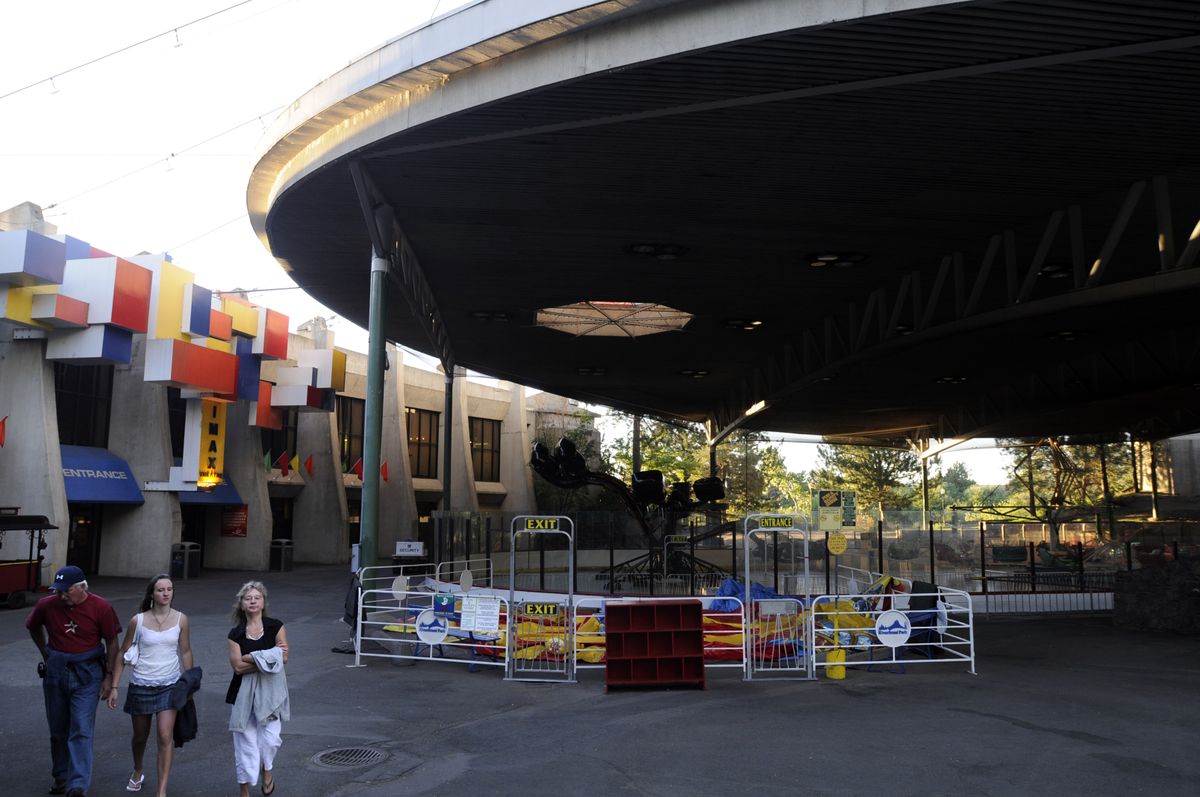Pavilion’s prognosis
Icon’s future uncertain despite illustrious past

It’s one of the most recognizable structures in Spokane. Yet its future is unclear.
As Riverfront Park celebrates its 30th anniversary today, the top of the U.S. Pavilion – the giant circus tent-like structure covering a hodgepodge of amusements – is covered with rust. One of the buildings it towers over hasn’t been used by the public since 1990. And many other activities and structures underneath are dated or need extensive maintenance.
A 1999 city report examining the pavilion said it needed $2.8 million in work. Much of that hasn’t been done because park officials haven’t settled on its long-term role.
“How much money do you spend on the facility when you don’t know what it’s going to be in the future,” said Craig Butz, Spokane parks recreation manager, who has worked at Riverfront Park since it opened.
Despite lingering questions, many say the pavilion should be a permanent part of Spokane’s landscape – even if activities below it are replaced.
“It’s a reminder of why that park was there. It says, ‘Expo got us here,’ ” said Ron Rector, a former Spokane Park Board member.
That feeling, however, isn’t universal. Former Mayor Dennis Hession, who served on the Park Board for most of the 1990s, said there are better icons of Expo ’74, such as the Great Northern Clocktower that was saved from the old railroad station to overlook the park. He added that the pavilion blocks access to the water and that attractions could be moved north of the river.
“They created a very large concrete edifice on the south bank of the north channel,” Hession said. “With limited resources in the park system, should we be spending that kind of money to preserve it?”
The federal government spent $6.6 million on the structure, which originally was covered in white canopy and opened just in time for Expo ’74. A few winters tore the covering and city leaders opted to maintain a naked version with cables and lights.
When plans were announced for the pavilion, officials said it might become home to an information center for the National Park Service after the fair closed. That never materialized and President Ford ordered that the pavilion be transferred to the city in 1975. After extensive debate the pavilion opened June 3, 1978, with a restaurant and IMAX theater. One of the new attractions was an exhibit recounting the history of Spokane. A few years later it was transformed into a science museum that has been closed since 1990.
Jon Magnusson, chairman and CEO of the Seattle firm that was in charge of the structural engineering of the pavilion, said the tent wasn’t meant to be permanent. Even so, it’s become an important landmark.
“I travel around the world all the time, and I look at that structure and the scale and the setting, and I think it’s really special,” said Magnusson, who joined his firm – then called Skilling, Helle, Christiansen and Robertson – soon after the pavilion was built.
Kirk Bayman, who rode through Riverfront Park on a skateboard Thursday, grew up in Spokane and studied the fair for a Cub Scout project.
“It’s iconic,” Bayman said. “If they got rid of the pavilion, that’s just one less thing that’s interesting.”
A city Riverfront Park plan developed in 2001 suggests many changes for the pavilion, but says the tent cables “will be retained in order to maintain the distinctiveness and character of the original structure.” That vision has not been adopted, Butz said.
The earlier report studying the pavilion and the cost to fix it takes no stand: “There is rationale to maintain the pavilion and rationale for removing the pavilion altogether.”
Part of the dilemma of the pavilion is the same that faces the whole of Riverfront Park. Is it a natural refuge in the center of town or the city’s central gathering place for community events?
Butz said it’s a combination, but Park Board members have long struggled to determine the proper balance.
“It’s kind of been in a standstill zone,” Butz said. “Lots of questions still need to be answered.”
In coming weeks, the Park Board may gain a clearer vision of the pavilion’s future if it can come to an agreement with officials working to create the Mobius science center. The museum is planned for the north bank of the park, complete with a new IMAX theater. But Mobius hasn’t met fundraising targets it agreed to in 2006, and the Park Board hasn’t approved a new agreement allowing Mobius to use park land.
If it goes forward, the city could relocate amusements at the pavilion near the museum, allowing the pavilion to be converted to an outdoor theatre and concert venue, which was proposed in the draft 2001 report. Plans also call for changes that would open the north side of structure to make it more accessible to the river.
Butz said attractions at the pavilion bring in revenue, but not enough to pay for maintenance that’s been deferred.
Andrew Siemer, a Californian in Spokane this week to visit his parents, brought his wife and six children to the pavilion on Thursday.
“They all love it,” Siemer said. “We came here Tuesday. They wanted to come back today.”
Expo ’74 President King Cole said the pavilion is a reminder that the city got more from the fair than a celebration.
The pavilion has “not just a nostalgic effect on me, but it has a ‘today effect’ in terms of its look and beauty,” he said.
But Cole, 86, warns that if it’s to remain a fixture in the heart of the city, it shouldn’t be left to rust.
“If it’s gonna be good, it’s gotta be good in a sense that it’s kept up.”